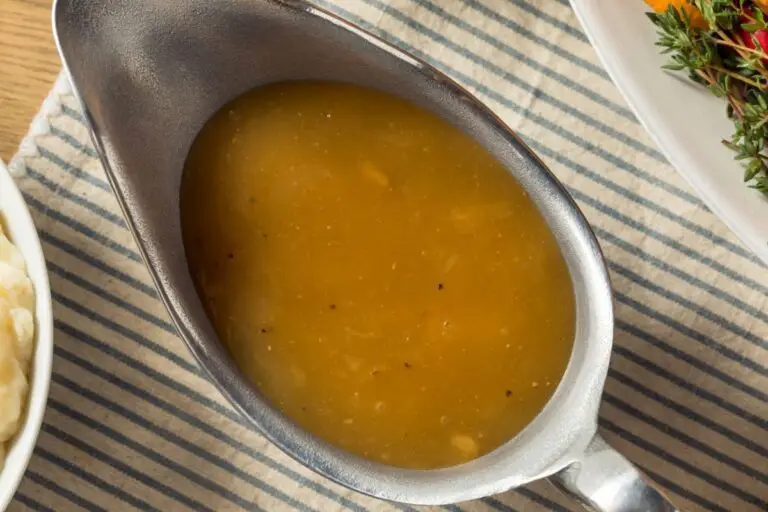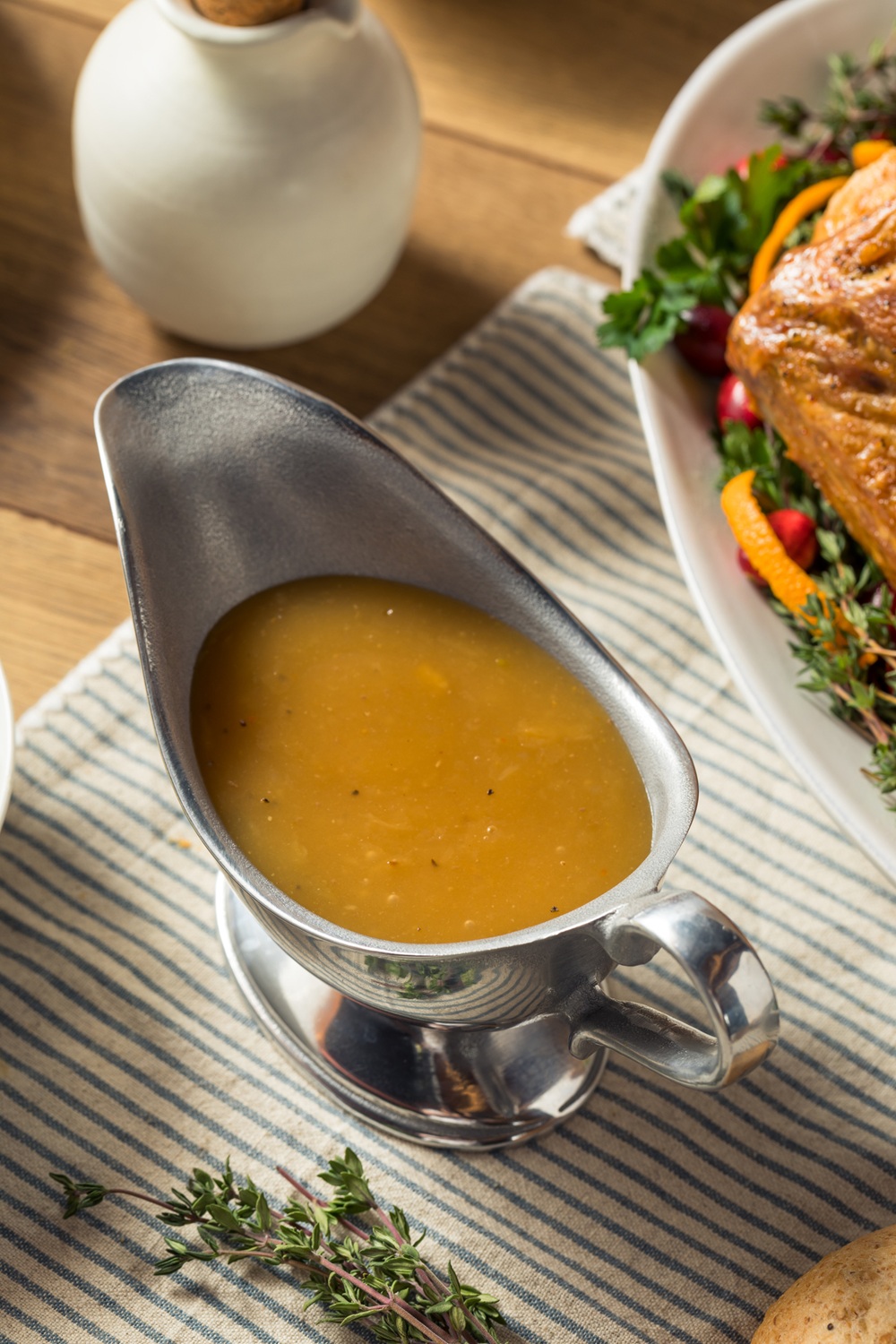This old fashioned giblet gravy from scratch transforms humble turkey or chicken giblets into rich, deeply flavorful gravy that turns every bite of holiday dinner into something worth savoring. The vintage technique of simmering giblets slowly creates a depth of flavor that no store-bought gravy can match.
Every holiday table deserves gravy that tastes like it was made with care. The aroma of slowly simmering giblets fills the kitchen with that unmistakable scent of a proper holiday feast, the kind that brings everyone to the table before dinner is even ready.
The 1970s Kitchen
Holiday dinners in the 1970s meant hours in the kitchen, but nobody minded. The house filled with the scent of roasting turkey while The Waltons played on the wood-paneled television in the living room. Women wore their best aprons, the ones saved for special occasions, and gathered in kitchens to share cooking duties and stories.
Wasting any part of the turkey or chicken was unthinkable. Every piece had purpose, from the drumsticks to the giblets tucked inside the cavity. Making giblet gravy was standard practice, a way to honor the whole bird and create something truly special from parts that might otherwise be discarded. The giblets simmered for hours on the stovetop, filling the kitchen with a savory richness that promised good things to come.
Families gathered around tables and passed serving dishes hand to hand. The gravy boat made its rounds, pouring that golden, giblet-studded sauce over mashed potatoes, turkey, and dressing. This was comfort food at its finest, born from practicality and perfected through generations.
What Makes This Giblet Gravy Special

Old Fashioned Turkey Giblet Gravy Recipe
Rich, savory giblet gravy made from turkey or chicken giblets, pan drippings, and aromatic vegetables. This vintage 1970s recipe creates deeply flavorful gravy perfect for holiday dinners.
- Total Time: 2 hours 40 minutes
- Yield: 3 cups 1x
Ingredients
- Turkey or chicken giblets (gizzard, heart, liver, neck)
- 4 cups water
- 2 celery leaves
- 1 small onion, sliced
- Salt to taste
- 2 tablespoons fat from roasting pan (or unsalted butter)
- 2 tablespoons all-purpose flour
- 1 cup lukewarm liquid (pan juices from roasted turkey or chicken, plus giblet broth)
- Cooked, chopped giblets
- Salt and pepper to season
Instructions
- Simmer the giblets: In a covered pan, simmer giblets in lightly salted water to cover. Add celery leaves and onion slices to the water. Cook turkey heart and gizzard for 2 to 2.5 hours, turkey liver for 30 minutes. Simmer broiler-fryer chicken heart and gizzard for 1 to 1.5 hours, liver for 5 to 10 minutes.
- Prepare the roasted bird: Transfer roasted turkey or chicken to platter. Leave crusty bits in pan and pour pan liquid into measuring cup.
- Skim the fat: When fat rises to the top of the pan liquid, skim it off. Measure 2 tablespoons of fat back into roasting pan.
- Make the roux: Add 2 tablespoons flour to the fat in the pan. Blend and cook over low heat, stirring constantly until frothy and lightly colored. If you prefer richer flavor and color, add a little kitchen bouquet at this stage.
- Build the gravy: Remove from heat and add 1 cup lukewarm liquid (pan juices plus giblet broth). Stir until smooth, then return to heat. Cook and stir constantly until the gravy thickens.
- Add the giblets: Stir in the cooked, chopped giblets. Simmer 5 minutes and season to taste with salt and pepper.
Notes
- For each cup of gravy, measure 2 tablespoons fat back into the roasting pan. Add 2 tablespoons flour and blend.
- The crusty bits left in the roasting pan add incredible depth of flavor to your gravy.
- Don’t skip the simmering time for the giblets. This slow cooking process creates the rich, savory foundation that makes this gravy exceptional.
- Some cooks prefer to omit the liver if they find the flavor too strong. The gravy will still be delicious with just the heart, gizzard, and neck meat.
- Prep Time: 10 minutes
- Cook Time: 2 hours 30 minutes
- Category: Sauces
- Method: Stovetop
- Cuisine: American
Nutrition
- Calories: 45
- Sodium: 85mg
- Fat: 3g
- Saturated Fat: 1g
- Carbohydrates: 2g
- Protein: 3g
- Cholesterol: 35mg
How to Make Perfect Homemade Giblet Gravy
Recipe Variations, Serving Ideas, and Storage
Recipe Variations
Frequently Asked Questions
Giblets typically include the neck, heart, gizzard, and liver. You'll find them packaged in a paper or plastic bag tucked inside the cavity of a whole turkey or chicken. Always remove this packet before roasting your bird.
Yes, if you don't have enough pan drippings, use the giblet broth you created by simmering the giblets. You can also supplement with chicken or turkey stock. The gravy won't have quite the same depth from the roasted pan bits, but it will still be flavorful.
Lumps form when flour isn't properly incorporated into the fat or when hot liquid is added too quickly. Always cook your roux thoroughly before adding liquid, remove the pan from heat when adding liquid, and whisk constantly as you pour. If lumps do form, strain the gravy through a fine-mesh sieve.
Turkey hearts and gizzards need 2 to 2.5 hours of simmering to become tender. Turkey liver only requires 30 minutes. Chicken giblets cook faster: hearts and gizzards need 1 to 1.5 hours, while liver takes just 5 to 10 minutes.
This is personal preference. Some people love the rich, mineral flavor liver adds, while others find it too strong. Try making the gravy with liver once, and if you don't enjoy the taste, simply omit it next time and use only the heart, gizzard, and neck meat.
Mix equal parts softened butter and flour together to create a beurre manié. Whisk small amounts of this paste into your simmering gravy until it reaches your desired thickness. Alternatively, make a slurry with 1 tablespoon cornstarch mixed with 2 tablespoons cold water.
Bland gravy usually needs more salt, or it wasn't made with enough flavorful pan drippings. Make sure you're scraping up all those brown bits from your roasting pan. Simmer the giblets with aromatic vegetables, and always taste and adjust seasoning before serving.
Of course you can, but you'll lose the distinctive giblet flavor that makes this gravy special. The long simmering of the giblets creates depth that store-bought broth cannot replicate. If you must substitute, at least brown the chopped giblets before adding them to gravy made with commercial broth.
Thin your gravy by whisking in small amounts of warm giblet broth, chicken stock, or even water. Add liquid gradually, a few tablespoons at a time, until you reach the consistency you prefer. Remember that gravy thickens as it cools, so err on the side of slightly thinner.
Does this recipe bring back memories of holiday dinners at your grandmother's table, or are you trying giblet gravy for the first time? I'd love to hear about your family's gravy traditions in the comments below! If you make this old fashioned giblet gravy from scratch, please leave a rating and review!


0 comments